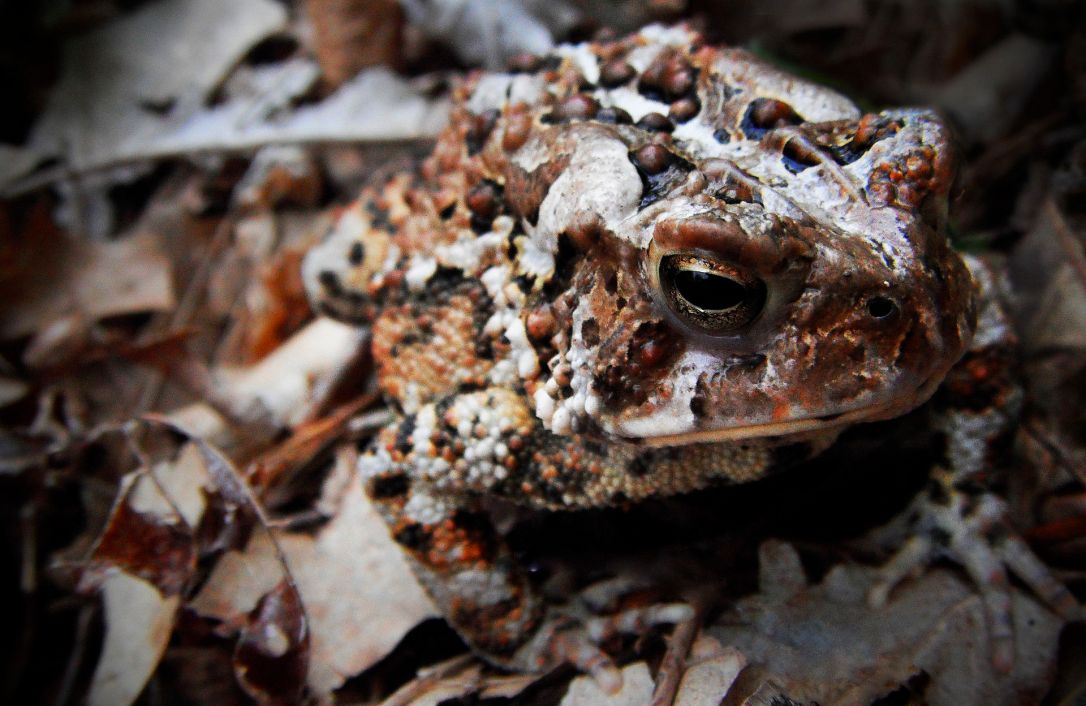Frogs and Toads of Michigan
If you are looking to identify a specific frog and can’t figure it out from the page, you can check my Frog Identification and see how to contact me about helping you out.
To see the frogs and toads located in just the Upper Peninsula of Michigan, click the link.
Frogs
True Frog Family – Ranidae
The True Frogs are your typical frogs that are generally found along the shores of a lake or pond.
American Bullfrog (Rana catesbeiana)
Common Name: American Bullfrog
Scientific Name: Rana catesbeiana
Location: Statewide
Breeding Season:
The American Bullfrog is the largest frog in the state. They are found near permanent bodies of water such as large ponds, streams, and lakes. Once the males of the species reach sexual maturity, their throats turn bright yellow. They are very similar to Green Frogs but they don’t have a dorsal ridge down their back. It wraps around their tympanum.
Common Name: Green Frog
Scientific Name: Rana clamitans
Location: Statewide
Breeding Season:
The Green Frog is a medium to large sized frog. They can be commonly found near pretty much any water body such as ponds, lakes, or streams. Once the males of the species reach sexual maturity, their throats turn bright yellow. Best way to tell them apart from other true frogs below is the dorsal ridge on its back does not go all the way down its back.

Mink Frog (Rana septrentionalis)
Common Name: Mink Frog
Scientific Name: Rana septrentionalis
Location: Upper Peninsula
Breeding Season:
Mink Frog has a marbled look to it compared to the other frogs.
Northern Leopard Frog (Rana pipiens)
Common Name: Northern Leopard Frog
Scientific Name: Rana pipiens
Location: Statewide
Breeding Season:
The Northern Leopard Frog has regular circles around its body. It also has a complete dorsal ridge. The Northern Leopard Frog varies in color from dark brown to slim green.
Common Name: Pickeral Frog
Scientific Name: Rana palustris
Location: Statewide
Breeding Season:
The Pickerel Frog is a medium to large sized frog. Their dorsal ridge runs down from their eye to their back and inside there is rectangular boxes.
Common Name: Wood Frog
Scientific Name: Rana sylvatica
Location: Statewide
Breeding Season:
The Wood Frog is a small to medium sized frog. They vary in color from brown, silver, or red and they have dark “raccoon” eyes. When winter comes, the Wood Frog can freeze completely solid and then unthaw in spring. They start to breed once the ice is off the ponds in late March / early April. After breeding season, they are often found in the woods, far away from any water bodies.
Tree Frog Family – Hylidae
Common Name: Blanchard’s Cricket Frog
Scientific Name: Acris blanchardi
Location: Southern half
Breeding Season:
The Blanchard’s Cricket Frog is a small, warty frog that varies in color from tan, brown, or green. They have a dark triangle between their eyes and a dark stripe on their thighs.
Eastern Gray Tree Frog (Hyla veriscolor) and Cope’s Gray Tree Frog (Hyla chrysoscelis)
Common Name: Eastern Gray Tree Frog
Scientific Name: Hyla versicolor
Location: Statewide
Breeding Season:
Common Name: Cope’s Gray Tree Frog
Scientific Name: Hyla chrysoscelis
Location: Central area
Breeding Season:
The Gray Tree Frogs are nearly identical besides their calls and chromosome numbers. These medium sized frogs can be found perched in trees or on the side of your house. They are not always gray in color and can be green. They have yellow or orange coloration on their back legs.
Here is a video of some Eastern Gray Tree Frog males calling that I took
Spring Peeper (Pseudacris crucifer)
Common Name: Spring Peeper
Scientific Name: Pseudacris crucifer
Location: Statewide
Breeding Season:
The Spring Peeper is a small chorus frog that can often be found on forest floor or low on trunks of trees. They can be hard to find due to their small size, however, in spring when they come to temporary ponds to breed, they are easier to find. They can be distinguished from the Chorus Frogs and Cricket Frogs due to their x on their back.
Video of a Spring Peeper calling, thanks to M Dwyer, @MustelidDwyer on twitter

Western Chorus Frog (Pseudacris triseriata)
Common Name: Western Chorus Frog
Scientific Name: Pseudacris triseriata
Location: Mainland
Breeding Season:
The Western Chorus has 3 lines down its back usually which makes it easier to tell apart compared to the Spring Peeper and Cricket Frog.
Boreal Chorus Frog (Pseudacris maculata)
Common Name: Boreal Chorus Frog
Scientific Name: Pseudacris maculata
Location: Upper Peninsula
Breeding Season:
The Boreal Chorus Frog is a small sized Chorus Frog, ranging from brown, red, tan, to olive in color. The Boreal Chorus Frog and the Midland Chorus Frog appear very similar. They both have three lines down its back but the Boreal Chorus Frog has shorter hind legs. Also they are found in different areas of the state.
Toads
True Toad Family – Bufonidae
The True Toads are your typical toad. They usually have a parotid gland behind their eyes that contain a poison called It is not advised to let your dog eat these guys.
American Toad (Anaxyrus americanus)
Common Name: American Toad
Scientific Name: Anaxyrus americanus
Location: Statewide
Breeding Season:
The American Toad is a medium sized toad with rough warty skin that’s primary brown in color but can have some black, gray, or red coloration. Their undersides are speckled. The American Toads’s parotid gland does not touch or connected to it by a spur. The toads can be found pretty much anywhere including urban areas.
Common Name: Fowler’s Toad
Scientific Name: Anaxyrus fowleri
Location: Western half of the state
Breeding Season:
The Fowler’s Toad is a small to medium sized toad ranging in color from brown, gray, and olive with a clear, white underside and a white stripe down its back. Its parotid gland touches its postorbital ridge.

The American Toad’s parotid gland is separated from the craniel crest while the Fowler’s Toad’s touches.





























































